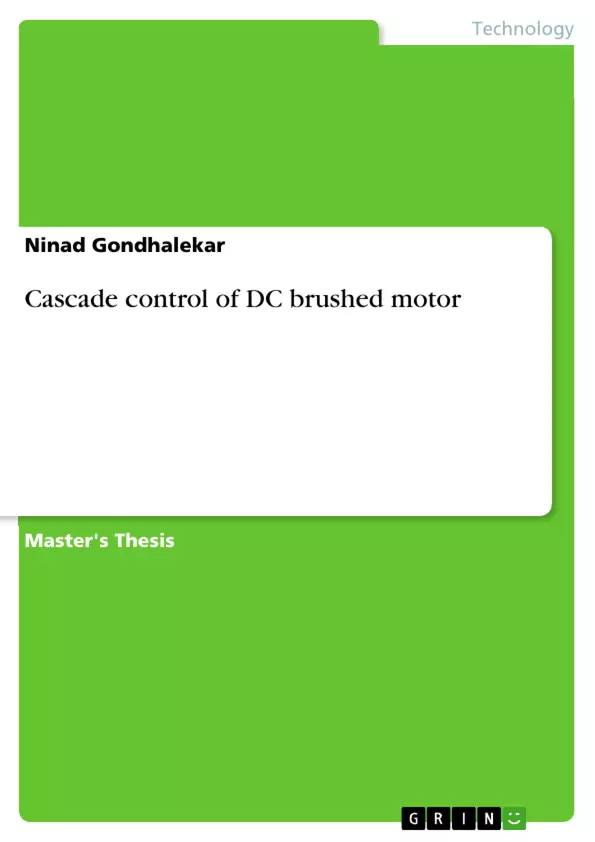The aim of this project is to control speed of permanent magnet DC motor by using technique called cascade control. In this project the working of PMDC motor, H-bridge using unipolar switching scheme, PI controller in current loop and speed loop of cascade control is first studied by simulating in MATLAB software and after that practically applied cascade control on PMDC motor using flexible inverter board. In this project dsPIC30F3010 is programmed and armature current and armature voltage is controlled by inner current loop and outer speed loop of coascade control. In this project investigation of effect of anti-windup C code on drive performance is done. The flexible board has microcontroller, current sensor and H-bridge circuit on it which will be used to supply voltage to PMDC motor. As a PMDC motor, DC motor rig is used which has two identical DC motor coupled together and one motor have encoder fitted on it and other motor have tacho-generator fitted on it.
Inhaltsverzeichnis (Table of Contents)
- INTRODUCTION
- HARDWARE
- DC motor test rig
- Flexible Inverter Board
- RL Load and Current Clamp
- dsPIC30F3010 microcontroller
- In-circuit debugger unit (ICD3)
- SOFTWARE
- MPLAB X IDE
- LABVIEW
- MATLAB
- Project Stages
- BACKGROUND THEORY
- Permanent Magnet DC Motor
- Mathematical Model of PMDC Motor
- Electrical Characteristics
- Mechanical Characteristics
- MATLAB simulation PMDC motor
- H-Bridge
- Four Quadrant (4Q) operation of DC motor
- Cascade speed control of Permanent DC Motor
- Current Loop
- Speed Loop
- Optical Encoder
- ADC CONVERSION
- C Code
- Experimental Results
- CONTROL of LEG A and LEG B of H-BRIDGE
- LEG-A of H-Bridge
- LEG-B of H-Bridge
- Role of Gate Driver IC IR2130
- C Code
- Experimental Results
- UNIPOLAR PWM SWITCHING OF H-BRIDGE
- Experimental results
- CURRENT CONTROL
- Experimental results
- SPEED CONTROL
- Experimental result
- INNER CURRENT LOOP
- Inner current Loop C Code
- Experimental Results
- OUTER SPEED LOOP
- Outer speed loop C Code
- Experimental result
Zielsetzung und Themenschwerpunkte (Objectives and Key Themes)
This project aims to control the speed of a permanent magnet DC motor using a cascade control technique. The project explores the operation of a PMDC motor, an H-bridge using a unipolar switching scheme, and PI controllers in both the current loop and speed loop of the cascade control. It investigates the practical implementation of cascade control on a PMDC motor using a flexible inverter board. The project also examines the effect of anti-windup C code on drive performance.
- Cascade control for DC motor speed regulation
- Operation of PMDC motors and H-bridges
- PI controllers for current and speed loops
- Practical implementation of cascade control
- Anti-windup C code and its impact on drive performance
Zusammenfassung der Kapitel (Chapter Summaries)
The project begins with an introduction to the hardware and software used, including the DC motor test rig, flexible inverter board, RL load, dsPIC30F3010 microcontroller, in-circuit debugger unit, MPLAB X IDE, LABVIEW, and MATLAB. The project then delves into the background theory of PMDC motors, H-bridges, and cascade speed control, including the mathematical model of the PMDC motor, its electrical and mechanical characteristics, and MATLAB simulations. It also discusses the four-quadrant operation of DC motors, the current loop, speed loop, optical encoders, and ADC conversion. The project then examines the control of the H-bridge's Leg A and Leg B, including the role of the gate driver IC IR2130. It concludes with experimental results for the control of the H-bridge, unipolar PWM switching, current control, speed control, and the inner and outer speed loops.
Schlüsselwörter (Keywords)
The project focuses on keywords such as cascade control, PMDC motor, H-bridge, unipolar switching, PI controller, current loop, speed loop, flexible inverter board, dsPIC30F3010 microcontroller, anti-windup C code, and drive performance.
- Quote paper
- Ninad Gondhalekar (Author), 2014, Cascade control of DC brushed motor, Munich, GRIN Verlag, https://www.grin.com/document/283511



